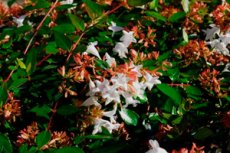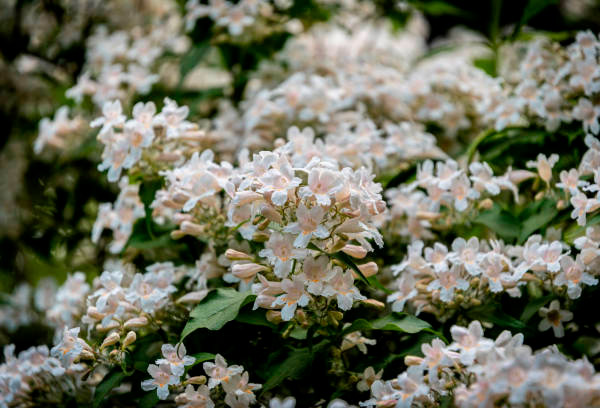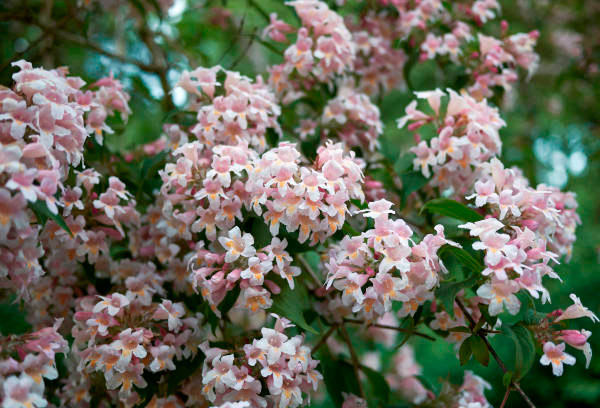New publications
Plants
Abelia
Last reviewed: 29.06.2025

Abelia is a genus of flowering shrubs prized for their ornamental foliage, abundant and prolonged blooming, and resilience to unfavorable conditions. Some Abelia species are cultivated as garden plants, while others are grown indoors or in greenhouses, where they enhance interiors and winter gardens effectively.
Abelias are relatively low-maintenance plants, making them an excellent choice for both novice and experienced gardeners. Their aesthetic appeal, with graceful shrub forms and delicate flowers, makes them a popular feature in landscapes and interior design, creating standout accents among other greenery.
Etymology
The name "Abelia" honors Dr. Clarke Abel, an English scientist and naturalist from the early 19th century, who contributed to the study of Chinese flora. It was in China that the first Abelia species were discovered, later introduced to European botanical collections.
Thus, the name "Abelia" commemorates the researcher, celebrating his travels and scientific efforts that enriched horticultural practices with new ornamental plants.
Life Form
In nature, Abelias are deciduous or evergreen shrubs, reaching heights of 0.5 to 2 meters. They form dense, branched structures with small to medium-sized leaves. Evergreen species retain their foliage year-round, while deciduous varieties shed leaves in winter, especially in cooler regions.
In indoor cultivation, Abelia typically maintains a compact size, as pot limitations and lighting conditions restrict growth. Proper care, including strategic pruning, ensures a neat shrub that retains its ornamental value even in confined spaces.
Family
Abelia belongs to the Caprifoliaceae (honeysuckle) family, which includes well-known plants such as honeysuckles (Lonicera), viburnums (Viburnum), and elderberries (Sambucus). Members of this family are found worldwide and exhibit a range of life forms, from herbaceous plants to woody shrubs and vines.
A shared feature among Caprifoliaceae species, besides similar floral characteristics, is their tendency to form shrubs and climbing plants, often valued for their decorative or edible qualities. Abelias are distinguished in this group for their abundant flowers, refined shrub shapes, and, in some cases, evergreen foliage.
Botanical characteristics
Abelia’s shoots can be upright or slightly arching, with bark often taking on a brownish or gray hue. The opposite leaves are typically ovate with pointed tips, and some species have slightly serrated edges. Leaf color ranges from light green to deep, glossy green.
The flowers are funnel-shaped or bell-like, appearing in clusters or as solitary blooms. Their colors are most often white, pink, or lilac, though cream and reddish hues are also seen. The flowering period can last for several weeks, during which the shrub remains highly decorative.

Chemical composition
The chemical composition of Abelia is not extensively studied, as the plant is primarily valued for its ornamental use. Leaves and flowers are believed to contain some flavonoids and essential oils, responsible for the light fragrance of certain species during blooming.
Abelia is generally not considered toxic, with no significant reports of harm to humans or animals. However, scientific data on the presence of potent compounds in Abelia is limited.
Origin
Abelia originates from East and Southeast Asia, including China, Japan, and Korea, where it thrives in undergrowth and forest edges, favoring moderately moist climates with ample sunlight. Some species have also been found in Mexico, indicating the genus's broad distribution in subtropical and warm regions.
The first Abelias introduced to Europe came from China in the 19th century, thanks to botanical expeditions. Over time, breeders and gardeners began propagating and distributing various species and hybrids, enriching the assortment of ornamental plants.
Ease of cultivation
Abelia is considered a relatively easy plant to grow, adapting well to different conditions. It responds positively to moderate watering, regular feeding, and bright but diffused lighting. Care mistakes such as inadequate watering, overwatering, or insufficient light may slow growth and reduce blooming, but the plant usually recovers quickly when conditions improve.
The main challenge lies in maintaining optimal air humidity and temperature during winter, especially when growing Abelia indoors or in greenhouses. Nevertheless, with basic care guidelines, Abelia exhibits good resilience and adaptability.
Species and varieties
The genus Abelia includes around 30 species, with the following being the most common in cultivation:
- Abelia x grandiflora (Large-flowered Abelia) – a hybrid known for abundant blooms.
- Abelia chinensis (Chinese Abelia) – features fragrant white flowers that bloom throughout warm seasons.
In addition to these species, numerous hybrid forms and cultivars are available, differing in leaf coloration and shrub shape. Some varieties feature variegated foliage or an extended blooming period.

Size
In natural conditions, Abelia can grow up to 1–2 meters tall, with a spread exceeding 1 meter, forming a sprawling crown. However, size varies depending on the species and growing environment.
When grown indoors, Abelia rarely exceeds 0.8–1 meter in height, as pot size and regular pruning limit growth. Achieving its maximum dimensions in a container takes several years, during which proper care gradually strengthens the plant.
Growth rate
Abelia exhibits moderate growth. During warm seasons, with adequate moisture and nutrition, the shrub produces several new shoots and significantly increases its foliage.
In winter or under adverse conditions (e.g., low light), growth slows down. Overall, the plant produces reasonably short seasonal growth, making it easy to maintain a neat shrub shape.
Lifespan
Abelia is a perennial plant that can retain its ornamental appeal for several years or even decades with proper care. In gardens or greenhouses, the shrub can live for an extended period, gradually growing larger and producing more abundant blooms.
In indoor cultivation, its lifespan can also be quite long but requires careful attention to watering schedules and periodic repotting. Rejuvenating pruning and propagation through cuttings help maintain the plant’s vitality and prolong its lifecycle.
Temperature
The ideal temperature range for Abelia is 18–25°C. In summer, it tolerates brief periods of heat (up to 28–30°C) provided it receives adequate watering and high humidity.
In winter, slightly cooler temperatures (15–18°C) are preferable, allowing the plant to rest without excessive energy expenditure during shorter daylight hours. Growth slows when temperatures fall below 10–12°C, and partial leaf drop may occur.
Humidity
Abelia prefers moderately humid air (around 50–60%). In very dry conditions, leaf tips may dry out, reducing overall ornamental value. Regular misting with warm, settled water benefits foliage and reduces the risk of spider mite infestations.
Excessive humidity combined with poor ventilation can lead to fungal diseases. Maintaining a balance by ensuring good air circulation and avoiding waterlogging is crucial.
Light and indoor placement
Abelia requires bright, diffused light. East or west-facing windows are ideal, where the plant receives direct sunlight in the morning or evening but is protected from intense midday rays.
On south-facing windows, shading is necessary during peak sunlight to prevent leaf burn. Conversely, insufficient light on north-facing windows may require supplemental lighting with grow lamps, especially during winter.
Soil and Substrate
Abelia requires loose, nutrient-rich, and well-draining soil with a slightly acidic reaction (pH 5.5–6.5). An optimal mix includes:
- 40% leaf or sod soil,
- 30% peat,
- 20% sand (or perlite),
- 10% fine gravel or vermiculite.
A drainage layer (2–3 cm of expanded clay or pebbles) at the bottom of the pot is essential to prevent water stagnation. This substrate structure ensures a good balance of air and moisture, promoting healthy root development.
Watering (summer and winter)
During warm months, Abelia requires regular watering to keep the soil consistently moist without waterlogging. The frequency should be adjusted based on the drying rate of the topsoil (1–2 cm). In hot weather or with strong sunlight, watering may need to be increased.
In winter, watering is significantly reduced, especially if the temperature drops to the recommended 15–18°C. During this period, the plant requires less moisture, and overwatering may cause root rot. Light soil moisture is sufficient, avoiding complete drying of the root ball.
Fertilization and feeding
During the active growth period (spring to mid-autumn), Abelia should be fed with complex fertilizers for flowering shrubs or universal compositions. Fertilize every 2–3 weeks, using slightly lower doses than recommended to avoid oversaturating the soil.
In winter, when growth slows, feeding is reduced (once every 1–2 months) or stopped entirely. Excess nutrients during dormancy can negatively affect the root system and foliage.
Flowering
Abelia is known for its abundant blooming, which can last for several weeks or even months under favorable conditions. The flowers are funnel-shaped, typically white or pink, and often emit a pleasant, subtle fragrance. They appear in clusters or panicles at the ends of the shoots.
In indoor cultivation, consistent flowering is achieved through adequate lighting, moderate watering, and timely feeding. Regular pruning is also crucial for stimulating the formation of more flower buds.
Propagation
The best time to propagate Abelia is in spring or early summer when growth processes are active. Propagation is commonly done by cuttings: semi-woody shoot tips (8–10 cm long) are cut, with lower leaves removed, and placed in a moist mix of peat and sand (or perlite). Growth stimulants can be used to speed up rooting.
Seed propagation is less common, as not all varieties produce viable seeds. Seeds are sown in a loose substrate and kept at 20–25°C with high humidity. Germination typically occurs within 2–3 weeks, but seedlings grow slowly and require careful care.
Seasonal features
In spring, Abelia actively grows foliage and new shoots, requiring increased attention to watering and feeding. In summer, the plant shows its most decorative appearance with vibrant leaves and abundant flowering. Regular watering and moderate feeding are essential during this time.
In autumn and winter, growth slows, and care is minimized with reduced watering. Lowering the temperature slightly helps the plant "rest," which promotes the development of new flower buds and strengthens the roots.
Care features
Abelia does not tolerate sudden temperature fluctuations or insufficient light. Cold drafts or low sunlight may cause leaf drop or hinder flowering. Overwatering leads to root rot and loss of decorative foliage.
Timely detection of problems (wilting leaves, lack of growth, discoloration) and adjustments to care routines help the plant recover quickly. Regular inspections ensure early detection of pests or disease symptoms.
Indoor care
For indoor Abelia, choose a bright location, preferably near east- or west-facing windows. Provide shading during hot hours on south-facing windows. Water as the topsoil dries: more frequently in summer, less in winter.
Moderate feeding during the active period (spring to autumn) supports abundant flowering and foliage growth. However, over-fertilizing should be avoided.
Maintain air humidity at 50–60%, occasionally misting leaves, especially in hot and dry conditions. Excessive humidity without proper ventilation can lead to fungal diseases.
Repot every 2–3 years, refreshing the soil and increasing the pot size if necessary. Be careful not to damage the roots during transplantation.
Repotting
The best time for repotting is spring, before active growth begins. Select a pot 2–3 cm larger in diameter than the previous one to give roots space to develop without excess soil volume.
Ceramic pots are breathable and allow moisture to evaporate, benefiting roots but drying out faster. Plastic pots retain moisture longer. The choice depends on personal preferences and room conditions.
Pruning and shaping
Pruning is necessary to maintain a compact shrub shape and stimulate branching. Early spring, before active growth, is the best time for this. Remove weak, elongated, and damaged shoots.
Overly long branches can be shortened by one-third or half their length, encouraging lateral growth. This increases crown density and supports abundant flowering, as new shoots often produce flower buds.
Common issues and solutions
Common problems include yellowing and dropping leaves, often caused by overwatering, lack of light, or sudden chilling. Solutions include optimizing watering, relocating the plant to a brighter spot, and protecting it from drafts.
Nutrient deficiencies (especially nitrogen and micronutrients) manifest as pale leaves, slow growth, and sparse flowering. Applying balanced fertilizers per dosage recommendations quickly rectifies these issues.
Pests
Abelia is vulnerable to aphids, spider mites, and scale insects. Signs of infestation include sticky residue, webbing, or small insects on the leaves. Isolate the plant and treat it with insecticides (or acaricides for mites) upon detection.
Preventive measures include keeping leaves clean, misting with warm water, avoiding overly dry air, and regularly inspecting the shrub. Early pest management combined with improved care conditions ensures a quick recovery.
Air purification
Like many indoor plants, Abelia participates in photosynthesis, absorbing carbon dioxide and releasing oxygen, improving room air quality. Its leaves can capture dust and some pollutants, contributing to a cleaner indoor environment.
Although specific studies are lacking, Abelia is recognized for its general positive impact on air quality, similar to most green plants.
Safety
Abelia is not considered toxic. Accidental ingestion of leaves by pets or children typically causes no severe poisoning, though consuming large amounts may lead to mild digestive upset.
Allergic reactions to Abelia are rare. People with sensitive skin are advised to use gloves during pruning and wash hands afterward to avoid potential irritation from the sap.
Winter care and preparation for spring
When grown indoors, mimic a dormant period by slightly lowering the temperature (15–18°C) and reducing watering. If maintaining warmth during winter, ensure adequate lighting and reduce watering and feeding frequency.
As spring approaches, gradually increase light exposure and watering, preparing the plant for active growth. Pruning and repotting, if necessary, should also be done at this time.
Benefits
Abelia's main advantage lies in its high decorative value, offering abundant blooms, a beautiful crown, and sometimes evergreen foliage. These features make it a standout element in interior decor or garden landscapes.
The presence of green plants like Abelia also contributes to a calming psychological environment, reducing stress and enhancing mood.
Use in traditional medicine or folk remedies
There is little information on the medicinal use of Abelia. Its biochemical composition is insufficiently studied for therapeutic applications, and the plant is primarily valued for its ornamental properties.
Attempts at self-medication using Abelia are not recommended, as there is no scientific evidence supporting its efficacy or safety.
Landscape use (decorative groupings, vertical gardens)
In warm regions, Abelia is often planted in open ground as a decorative shrub for borders, flower beds, or as a solitary focal point on lawns. Its abundant flowering and neat crown complement other garden plants.
Due to its need for space and sunlight, Abelia is rarely used in vertical gardens or hanging compositions. However, compact varieties can be included in mixed arrangements with other shrubs if provided suitable conditions.
Compatibility with other plants
Abelia pairs well with decorative foliage and flowering plants requiring similar watering and lighting conditions, such as coleus, fuchsia, or pentas. Allow sufficient space for its crown to avoid shading or competition for resources.
In mixed plantings or group arrangements, consider growth rates to prevent more vigorous plants from overshadowing Abelia. Combining it with plants that bloom at different times can extend the decorative effect of the ensemble.
Conclusion
Abelia is a versatile and low-maintenance plant that brings elegance and charm to interiors or gardens. Its strengths include abundant flowering, vibrant foliage, and adaptability to various growing conditions. With proper care (moderate watering, adequate lighting, and regular feeding), Abelia responds with vigorous growth and extended blooming periods.
Watching this tropical shrub thrive indoors, rewarding the owner with its exquisite white or pink flowers, provides aesthetic delight. Abelia can serve as a focal point in decorative arrangements or harmoniously complement an existing collection of houseplants or garden specimens.
